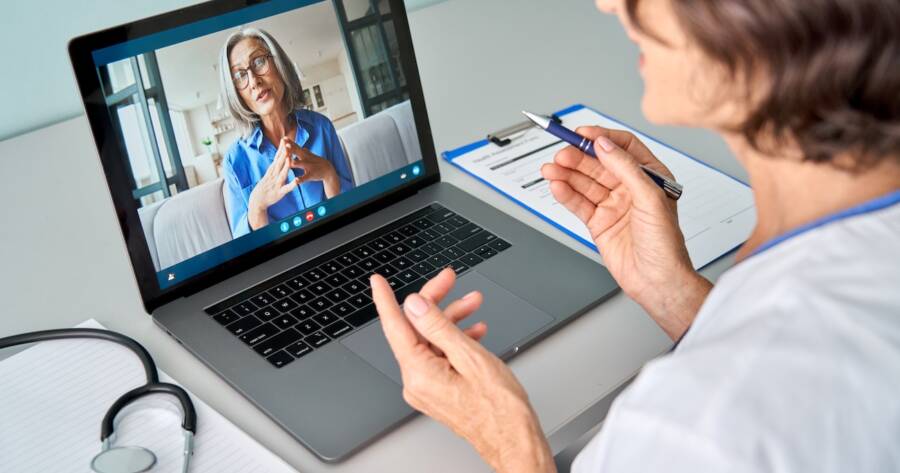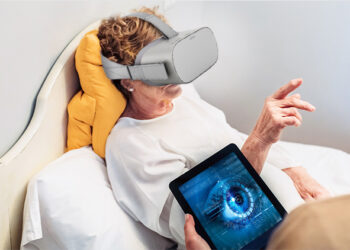The way we access medical care is undergoing a profound transformation. The rise of telehealth, the use of digital technology to deliver healthcare services remotely, is reshaping the landscape of medicine. What was once a niche offering is now a mainstream solution, providing unparalleled convenience, accessibility, and efficiency for both patients and providers. From virtual doctor’s visits and remote monitoring to digital health platforms, telehealth is breaking down geographical barriers and making quality medical care more readily available than ever before. This comprehensive article will delve into the driving forces behind the telehealth revolution, its wide-ranging applications, and the challenges and opportunities that lie ahead, offering a glimpse into a future where healthcare is no longer confined to a physical clinic.
The Catalysts of the Telehealth Revolution

The telehealth movement has been building for years, but a combination of technological advancements, changing patient expectations, and global events has accelerated its adoption to a point of no return.
A. Technological Advancements: The widespread availability of high-speed internet, powerful smartphones, and user-friendly video conferencing platforms has made virtual consultations seamless and reliable. The development of connected medical devices, from smartwatches that track heart rate to at-home glucose monitors that sync with a doctor’s app, has further expanded the capabilities of remote care.
B. Changing Patient Expectations: Modern consumers expect convenience and on-demand services in every aspect of their lives, and healthcare is no exception. Telehealth meets this demand by offering flexible appointment times, the ability to see a doctor from the comfort of one’s home, and reduced travel time and costs.
C. The Global Pandemic: The COVID-19 pandemic acted as a major catalyst, forcing a rapid and widespread adoption of telehealth. With in-person visits deemed risky, virtual consultations became a lifeline for maintaining continuity of care. The pandemic not only proved the viability of telehealth but also accustomed both patients and providers to its use, fundamentally changing perceptions.
D. Addressing Healthcare Shortages: In many rural and underserved areas, there is a shortage of medical professionals and specialists. Telehealth provides a powerful solution by connecting patients in remote locations with doctors and specialists who are located in urban centers, effectively democratizing access to care.
E. Cost-Effectiveness: Telehealth can be a more cost-effective option for both patients and the healthcare system. It reduces overhead costs for clinics, minimizes travel expenses for patients, and can lead to more efficient use of a provider’s time.
The Diverse Applications of Telehealth
Telehealth is not a single tool but a collection of technologies and services that span the entire healthcare spectrum. Its applications are wide-ranging and are transforming various medical fields.
A. Live Video Consultations (Telemedicine): This is the most common form of telehealth, where a patient and a doctor connect in real-time via video conference. This can be used for a variety of purposes, including:
* Follow-up appointments and medication management.
* Mental health therapy and counseling.
* Dermatology consultations for skin conditions.
* General wellness checks and minor illness diagnoses.
B. Remote Patient Monitoring (RPM): RPM uses connected medical devices to collect and transmit a patient’s health data to a provider. This is particularly useful for managing chronic conditions like heart disease, diabetes, and hypertension. Devices like smart blood pressure cuffs, continuous glucose monitors, and wearable fitness trackers can provide a continuous stream of data, allowing doctors to intervene early if a problem arises.
C. Store-and-Forward Technology: This involves the asynchronous transmission of medical information, such as images, videos, and patient data, to a specialist for review. A patient might see their primary care doctor, who then takes a picture of a skin rash and sends it to a dermatologist for an expert opinion. This is particularly effective in fields like radiology and pathology.
D. Mobile Health (mHealth): mHealth encompasses a wide array of health-related applications and platforms that are accessed via a mobile device. This includes apps for:
* Fitness and nutrition tracking.
* Medication reminders.
* Symptom checkers and health information databases.
* Virtual reality (VR) and augmented reality (AR) apps for therapeutic purposes.
E. Virtual Hospital and Emergency Care: In some cases, telehealth is being used to provide virtual emergency care. For instance, in a rural hospital without a specialist, a doctor can use a telehealth platform to consult with a specialist in a larger hospital in real-time, allowing them to make a more informed decision about a patient’s care.
The Benefits of a Telehealth

Embracing telehealth as a primary mode of care delivery offers a multitude of benefits for everyone involved in the healthcare ecosystem.
A. For Patients:
* Increased Accessibility: Patients in rural areas or with mobility issues can access specialists and primary care without the need for long-distance travel.
* Greater Convenience: No more taking time off work, arranging for childcare, or dealing with traffic and parking.
* Improved Engagement: Telehealth allows for more frequent check-ins and better communication, which can lead to higher patient engagement and better adherence to treatment plans.
* Privacy and Comfort: For sensitive topics like mental health, many patients feel more comfortable discussing their issues from the privacy of their own home.
B. For Providers and Clinics:
* Enhanced Efficiency: Providers can see more patients in a day by reducing the time spent on administrative tasks and non-clinical interactions.
* Reduced Overhead: Clinics can reduce their operational costs by requiring less physical space and staff.
* Improved Patient Follow-up: Telehealth makes it easier for providers to follow up with patients, leading to better outcomes and reduced hospital readmissions.
* New Revenue Streams: Telehealth allows providers to expand their reach, serving patients beyond their immediate geographical area.
C. For the Healthcare System:
* Cost Reduction: By reducing hospital readmissions and the need for emergency room visits, telehealth can lead to significant cost savings for the overall healthcare system.
* Better Data Collection: RPM and mHealth platforms provide a continuous stream of data that can be used for public health research, disease tracking, and improving treatment protocols.
* Resource Optimization: Telehealth allows for a more efficient allocation of resources, ensuring that specialists and medical equipment are used where they are most needed.
Challenges and the Road Ahead
Despite its many benefits, the widespread adoption of telehealth is not without its challenges. These hurdles must be addressed to ensure its equitable and effective use.
A. Regulatory and Legal Frameworks: The legal and regulatory landscape for telehealth is still evolving. Issues like licensing, reimbursement, and data privacy need to be standardized across different states and countries to ensure a seamless and compliant system.
B. Data Security and Privacy: The transmission of sensitive patient data over digital networks raises concerns about security and privacy. Robust encryption, secure platforms, and clear regulations are essential to build and maintain patient trust.
C. Digital Literacy and Access: Not everyone has access to a reliable internet connection or the digital literacy required to use telehealth platforms. This “digital divide” could exacerbate existing health inequalities, making it crucial to invest in infrastructure and training to ensure equitable access.
D. The Limits of Remote Care: Telehealth is not a replacement for all types of in-person care. Physical examinations, surgeries, and other hands-on procedures still require a physical presence. The key is to find the right balance between remote and in-person care.
E. Reimbursement and Payment Models: For telehealth to be sustainable, providers need to be properly reimbursed for their services. Many insurance companies have only recently begun to cover telehealth, and payment models still need to be standardized and integrated into the broader healthcare system.
The Future of Healthcare
The future of healthcare is not purely virtual or purely in-person; it’s a hybrid model that leverages the best of both worlds. We are moving toward a system where telehealth and in-person care are seamlessly integrated to provide a more holistic and personalized patient experience.
First, AI and predictive analytics will play an even greater role. AI-powered platforms will analyze data from remote monitoring devices to identify potential health issues before they become critical. They will also assist doctors in making more informed diagnostic and treatment decisions.
Second, there will be a greater emphasis on mental health and wellness. Telehealth has already proven to be a highly effective platform for mental health support, and this will continue to grow, with more virtual therapy, counseling, and mental wellness apps.
Third, the virtual hospital will become a reality. Patients will be able to receive a wide range of services, from a virtual emergency room visit to a post-operative check-in, all from the comfort of their home. This will reduce hospital overcrowding and make healthcare more convenient.
Finally, the digital health ecosystem will become more integrated. A patient’s health data, from their doctor’s notes to their smartwatch readings, will be seamlessly shared between providers, allowing for a more coordinated and effective approach to care. This will lead to a more proactive healthcare system that focuses on preventing illness rather than just treating it.
Conclusion
The rise of telehealth is more than just a technological trend; it is a fundamental shift in the delivery of healthcare. By breaking down the traditional barriers of time and distance, it is making quality medical care more accessible, convenient, and efficient for millions of people. From virtual consultations that save time and money to remote monitoring that helps manage chronic diseases, telehealth is already transforming the lives of patients and providers alike. It has proven its value in a time of crisis and is now poised to become a permanent and integral part of the healthcare system.
However, as we embrace this new era, it is crucial that we address the challenges that lie ahead. The issues of digital equity, data security, and regulatory frameworks are not insignificant. They require a collaborative effort from policymakers, healthcare leaders, and technology innovators to ensure that the benefits of telehealth are realized by all. The future of healthcare is a hybrid model, one that uses technology to complement and enhance human connection. It is a future where a doctor’s expertise is no longer limited by their location, and a patient’s health is no longer hindered by their circumstances. The telehealth revolution has begun, and it promises to create a more equitable, efficient, and patient-centered healthcare system for generations to come.










Discussion about this post